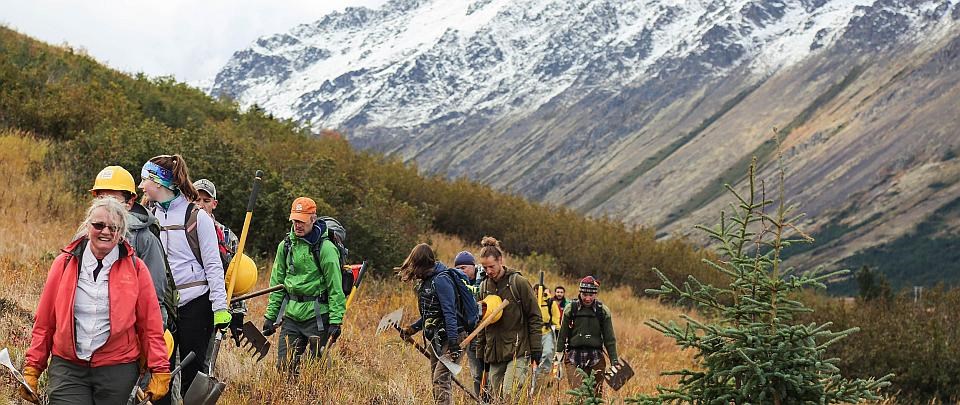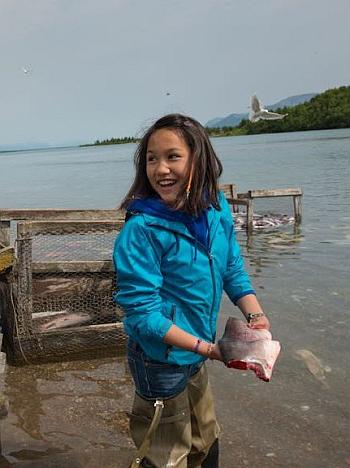
Alaska Trail Stewards, a RTCA project partner, hosts frequent volunteer trail work days throughout the summer and fall. NPS Photo/Mike Downs
National park areas in Alaska are spread from Sitka to Kotzebue, and from the Alaska Peninsula to the Canadian border. But the work of NPS professionals extend beyond park boundaries and benefit many communities not usually associated with national parks. For more information on how NPS works with partners and communities across the nation, visit the NPS Community Assistance Directory.
Alaska Native Communities and Federally Recognized Tribes
The National Park Service has a unique political relationship with Native American tribes which is based in the U.S. Constitution and hundreds of treaties, statutes, regulations, and policies, and strengthened by a shared commitment to stewardship of the land and resources. The Service honors its trust responsibilities to federally recognized tribes, in part, through government-to-government consultation on Service actions that may have a direct or substantial impact to the interests of the 229 federally recognized tribes in Alaska. The Service also works closely with Alaska Native Claims Settlement Act (ANCSA) Regional and Village Corporations through collaboration and consultation.
NPS recognizes and appreciates the contributions and knowledge that Indigenous people can share with us to better implement public land policies and procedures that will work to preserve and protect not only the physical and cultural resources that make the conservation units in Alaska so special but the intact traditional lifestyle based upon utilizing the resources.
The Shared Beringia Heritage Program
The Beringian Heritage Program is helping strengthen ties between Northwest Alaska and Russia, areas that share ancient traditions as well flora and fauna.
The Rivers, Trails, and Conservation Assistance Program
The Rivers, Trails, and Conservation Assistance Program (RTCA) helps bring technical expertise to communities to enhance close to home recreation opportunities through the creation and improvement of local trail systems, green spaces, and waterways. RTCA has been involved with communities across Alaska, lending technical expertise on a variety of projects including singletrack bicycle trails, all-terrain vehicle trails, and designing sustainable hiking routes. Communities interested in RTCA assistance apply annually to the NPS, describing the type of assistance that is sought. Community involvement is a big part of most RTCA projects, whether on-the-ground volunteers or participation in community discussions about a project's goals.
Affiliated Areas
The Service also works with partners from many communities who share our commitment to conservation, preservation and recreation. In one such partnership, the National Park Service helps fund and administer the Kenai Mountains-Turnagain Arm National Heritage Area, an entity championed by Anchorage and Kenai Peninsula residents and established by Congress to recognize the unique resources and opportunities in the area. The association's board of directors plans projects with other partners to help conserve historic resources in a large area between Anchorage and Seward.
 Alaskan Subsistence
Alaskan Subsistence
The largest number of communities are engaged with the National Park Service through the subsistence hunting, fishing, and trapping practices that occur within several national parklands. Grounded in the 1980 Alaska National Interest Lands Conservation Act (ANILCA), Congress recognized that local, rural residents should be able to continue using vast areas of federal land in Alaska in traditional ways and established a subsistence priority. The NPS manages subsistence in most park and preserve units in Alaska, and participates with local users in the extensive public process used to develop regulations and other management tools.
Partners
The National Park Service also partners with nonprofit groups such as Alaska Geographic, a cooperating association which works closely with the National Park Service in Alaska to extend our education mission to a broader audience. Alaska Geographic also works in a similar capacity with other public land managers across the state. You'll find them operating bookstores within several NPS visitor centers, as well as carrying out field based education programs in parks and elsewhere. A portion of the funds earned by Alaska Geographic are returned to the NPS each year to further the Service's ability to provide programs for visitors.
Cultural Resource Assistance
Partnerships & Community Assistance
Last updated: September 16, 2025
